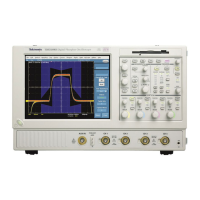291
Spectral Analysis Overview
You can use math waveforms to perform FFT (Fast Fourier Transform) measurements with the
instrument. The FFT process mathematically converts the standard time-domain signal (repetitive
or single-shot acquisition) into its frequency components, providing spectral analysis capabilities.
The ability to quickly look at a signal’s frequency components and spectrum shape is a powerful
research and analysis tool. FFT is an excellent troubleshooting aid for:
Testing the impulse response of filters and systems
Measuring harmonic content and distortion in systems
Identifying and locating noise and interference sources
Analyzing vibration
Analyzing harmonics in 50 and 60 Hz power lines
Spectral Analysis Features
FFT Windows. FFT windows let you match the optimum window to the signal you are
analyzing. The Rectangular window is best for nonperiodic events such as transients, pulses,
and single-sequence acquisitions. The Hamming, Hanning, and Blackman-Harris windows are
better for periodic signals. The Kaiser Bessel window has less spectral leakage than the
Hanning, Hamming, or Rectangular windows. The Gaussian window provides optimal
localization in both the time and frequency domain. The Flattop2 window is good for high
accuracy magnitude measurements for signals that do not require narrow resolution
bandwidth. The Tek Exponential window is useful for impulse response testing.
Waveform Analysis. You can display an FFT waveform on any actively acquired signal
(periodic or single-shot), the last acquired signal, or any signal stored in reference memory.
Vertical Scales. The FFT vertical graticule can be set to either dB or Linear RMS. A dB scale
is useful when the frequency component magnitudes cover a wide dynamic range, letting you
show both lesser and greater magnitude frequency components on the same display. A Linear
scale is useful when the frequency component magnitudes are all close in value, enabling
direct comparison of their magnitudes.
Spectral and Time-Domain Displays. The time signals and FFT waveforms can be shown
together on the display. The time signal highlights the problem; the FFT waveform helps you
determine the cause of the problem.
FFT Process
The FFT process mathematically converts the standard time-domain signal (repetitive or single-
shot acquisition) into its frequency components.
The FFT function processes the waveform record and displays the FFT frequency domain record,
which contains the input signal frequency components from DC (0 Hz) to ½ the sample frequency
(also called the Nyquist frequency).

